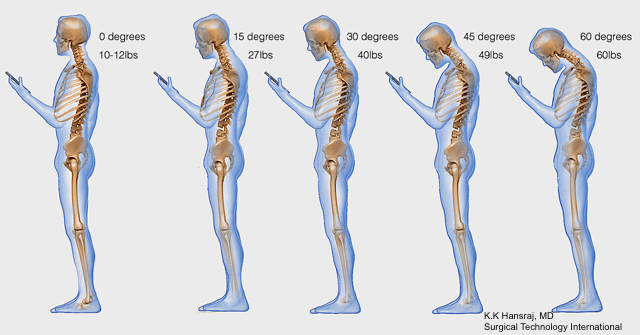How To Be A Smart Smartphone User

If you use a smartphone or tablet for more than one hour everyday, you definitely need to learn how to use it more intelligently… and no, i am not referring to another new app that will help you streamline your workflow.
The exponential growth in mobile technology has made it possible for people from all walks of life, young and old to own a mobile device. People not only using mobile devices for texting or phone calls but to read emails and eBooks, interact within social-media circles, play games and watch videos. This forces them to hold their necks in a bent position for long periods, creating excessive strain on the ligaments, tendons and muscles of the cervical vertebrae.
Unfortunately many of us ignore the aches and pains that occur while using our mobile devices, but it is only a matter of time before we begin to experience more serious problems like:
• Tension headaches
• Blurred vision
• TMJ syndrome (jaw pain)
• Joint pain
• Muscular tension and stiffness in the neck, shoulders and back
• Tingling down the arm and fingers
What is the real cause behind the neck pain
Your neck is at its most relaxed and comfortable state when the weight of your head is positioned directly on top of your spine. The muscles around the front, back and side of your neck should be working together to hold your head in a neutral position – looking straight ahead - this is the most natural state or position of the neck. So when you use a mobile device for prolonged periods with a bent and rotated neck, this will create an unnatural position, which leads to overuse injuries.
Of course, bending and turning your neck in various directions is encouraged because the cervical vertebrae are designed to facilitate free movement in all directions. However, you must be aware of your posture and make sure that your neck does not remain in awkward positions for long periods and returns to the neutral position.

On average, people use mobile devices for two to four hours a day. In other words, our necks are bent and held in a forward head position for 700 to 1,400 hours every year. It is the cumulative effect of years of overuse and stress that leads to degeneration and serious neck and back problems.
How to minimize the damage
Dr. Ezriel Kornel, a neurosurgeon from New York has offered some suggestions for computer and mobile users to reduce the damage caused by poor posture:
• Keep your phone or tablet at a higher level so you are not continually bending your head forward
• The Alexander technique is beneficial as it helps you become aware of how you use your body and teaches you optimal body positioning and poise
• If you suffer from neck pain or headaches, use mobiles phones in moderation to help reduce excessive strain on the neck
• Take frequent breaks. Stretch your neck and reposition your body to relieve the accumulated tension (using an app to remind you can be very useful)
Whether you like it or not, using a mobile device has become a part of our daily lives and it is here it to stay. So it is important that you are aware of the negative effects of prolonged mobile use, especially with your neck bent forwards. Not only will it improve your posture but it will also decrease your stress levels, reduce muscular aches and pains and be one the keys to stopping your headache and migraine pain… you will have become a smart smartphone user.
________________________
Pablo Tymoszuk is a soft tissue therapist specialising in remedial, myofascial and dry needling techniques. He also acts as an ergonomic specialist and wellness consultant which has motivated him to co-author the eBook Stop Headaches Naturally.
Together with Dr Margaret Scarlett they present a range of strategies for stopping headaches and migraines without drugs. All strategies are organized in a systematic manner and backed up by references to the scientific literature.
Smartphones Are A Hazard For Posture

Our smartphone obsession is putting Australians at risk of becoming a nation of hunch-backs, experts fear.
Chiropractors and physiotherapists are reporting a marked increase in the number of patients being treated for neck and shoulder complaints due to smartphone use.
Arthritis and Osteoporosis Victoria forecasts cases of arthritis and other musculoskeletal conditions will almost double to 8.7 million Australians within 20 years, with health costs estimated to be around $4.8 billion a year.
Australian Chiropractor Association spokesman Dr Michael Black said patients were experiencing headaches, upper back pain, sprains and muscle spasms. “While many people are tablets it appears that their ‘normal’ postural positioning has transformed people to developing rounded shoulders and subsequent forward head carriage leading to upper neck and upper back pain, resulting,” in headaches or migraines.”
Herald Sun | Richard Noone
Are suffering with headaches, back pain and spasms?
Do you need some help improving your posture?
Then have a look at just a few sections of Chapter 8 in the book Stop Headaches Naturally
IMPROVE POSTURE
- 8.2 What does having good spinal posture mean?
- 8.4 The wall test to assess and improve spinal posture
- 8.6 Modern work and leisure sets us up for bad posture
- 8.7 Mobile electronic devices and forward head posture
- 8.9 Set up your computer to minimize postural stress
CORRECT BREATHING
- 8.18 Diaphragmatic breathing & headache prevention
- 8.19 Learn how to breathe using your diaphragm
RETRAIN CORE MUSCLES
- 8.20 Spinal posture and the core postural muscles
DO SPECIFIC EXERCISES
- 8.21 Why exercises are important for headache prevention
- 8.23 Two part exercise for correcting forward head posture
Pablo Tymoszuk is a soft tissue therapist specialising in remedial, myofascial and dry needling techniques. He also acts as an ergonomic specialist and wellness consultant which has motivated him to co-author the eBook Stop Headaches Naturally.
Together with Dr Margaret Scarlett they present a range of strategies for stopping headaches and migraines without drugs. All strategies are organized in a sy





